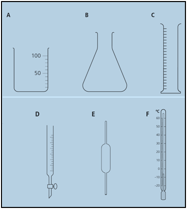RoseMarie Gallagher and Paul Ingram Solutions for Chapter: In the Lab, Exercise 2: Q
RoseMarie Gallagher Chemistry Solutions for Exercise - RoseMarie Gallagher and Paul Ingram Solutions for Chapter: In the Lab, Exercise 2: Q
Attempt the free practice questions on Chapter 19: In the Lab, Exercise 2: Q with hints and solutions to strengthen your understanding. Complete Chemistry for Cambridge IGCSE® Second Edition solutions are prepared by Experienced Embibe Experts.
Questions from RoseMarie Gallagher and Paul Ingram Solutions for Chapter: In the Lab, Exercise 2: Q with Hints & Solutions
In the experiment to compare the amount of sodium hydroxide in two kitchen cleaners, was there a dependent variable? If so, what was it?
Look at the apparatus below. Which pieces did the student use in the experiment to compare the amount of sodium hydroxide in two kitchen cleaners? Give their letters and names.

When measuring out solutions for titration, a pipette is used instead of a measuring cylinder. Why is this?
Why is a conical flask used rather than a beaker, for the titration?
Why are burettes used for titrations?
Which is more accurate for measuring liquids? (i) a burette (ii) a pipette. Explain clearly why you think so.
What is the difference between a burette and a pipette ?
Which item below will the student definitely use in an experiment to see whether neutralisation is exothermic or endothermic?

